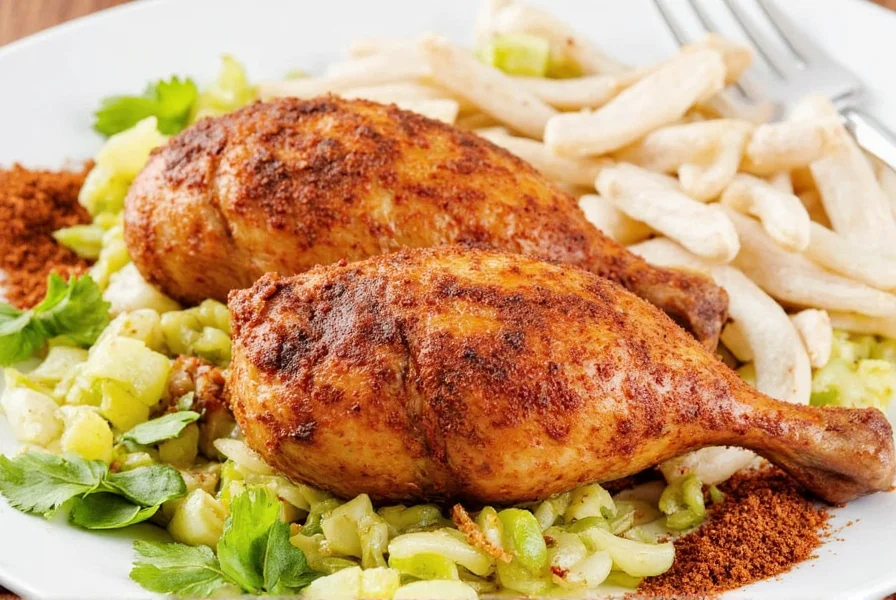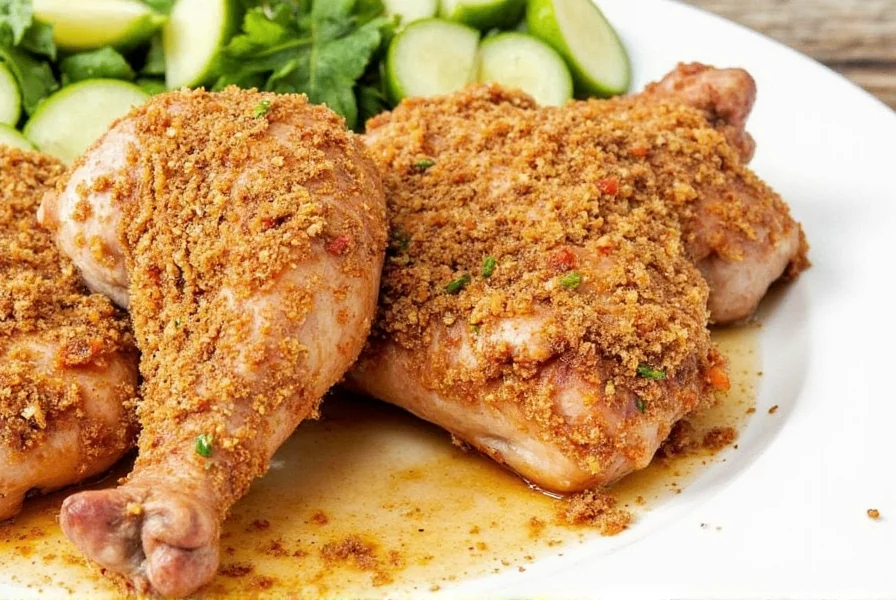When searching for the best spice rub for chicken, you need a blend that enhances flavor without overpowering the meat, creates a crispy crust, and works with your cooking method. As a professional chef with over 15 years of experience in grilling and barbecue, I've tested hundreds of spice rubs and can confidently recommend these top options based on flavor profile, versatility, and results.

Why This Rub Works Best for Chicken
Chicken is a versatile protein that benefits from spice rubs that balance flavor without masking its natural taste. The perfect chicken rub should:
- Enhance natural chicken flavor without overpowering it
- Create a crispy, flavorful crust when cooked
- Work well with multiple cooking methods (grilling, roasting, smoking)
- Use high-quality, fresh ingredients that don't contain fillers or artificial additives
Top 5 Homemade Spice Rub Recipes for Chicken
| Rub Name | Key Ingredients | Best Cooking Method | Flavor Profile |
|---|---|---|---|
| Classic Southern Smoke | Smoked paprika, brown sugar, garlic powder, onion powder, cayenne | Smoking or grilling | Smoky, slightly sweet, with a hint of heat |
| Mediterranean Herb Blend | Dried oregano, thyme, rosemary, lemon zest, garlic powder | Oven roasting | Fresh, herbal, citrusy |
| Spicy Cajun Kick | Cajun seasoning, paprika, garlic powder, onion powder, cayenne | Grilling or pan-searing | Spicy, savory, with robust flavor |
| Asian-Inspired Ginger-Sesame | Ginger powder, sesame seeds, garlic powder, soy sauce powder, brown sugar | Stir-frying or baking | Sweet, savory, umami-rich |
| Simple All-Purpose | Garlic powder, onion powder, paprika, salt, black pepper | Any method | Balanced, versatile, crowd-pleasing |
How to Apply Spice Rubs for Maximum Flavor
Proper application is crucial for getting the most from your spice rub. Here's how to do it right:
- Pat chicken completely dry with paper towels before applying rub (moisture prevents crispiness)
- Use about 1 tablespoon of rub per pound of chicken
- For best results, apply rub at least 30 minutes before cooking (up to 4 hours for deeper flavor)
- For grilling, apply rub just before cooking to prevent burning
- For roasting or baking, apply rub 1-2 hours ahead for better penetration
Top 5 Commercial Spice Rubs for Chicken
| Product | Flavor Profile | Heat Level | Best For | Price Point |
|---|---|---|---|---|
| Badia All-Purpose Seasoning | Garlic, onion, herbs | Low | Everyday cooking, beginners | $ |
| McCormick Grill Mates Cajun | Cayenne, paprika, garlic | Medium-High | BBQ, smoked chicken | $$ |
| Spiceology Chicken Rub | Smoked paprika, brown sugar, garlic | Medium | Grilling, smoking | $$ |
| Lawry's Seasoned Salt | Salt, paprika, garlic, onion | Low | Oven roasting, quick meals | $ |
| Primal Kitchen Lemon Pepper | Lemon, pepper, herbs | Low | Health-conscious cooks, light dishes | $$$ |
How to Choose the Right Spice Rub for Your Needs
Not all spice rubs are created equal. Consider these factors when selecting the perfect rub:
- Cooking method: Grilling needs rubs that won't burn easily, while roasting benefits from more complex flavors
- Chicken cut: Thicker cuts like breasts need more robust flavors, while delicate cuts like tenderloins benefit from lighter blends
- Dietary preferences: Check for gluten-free, sugar-free, or allergen-free options if needed
- Ingredient quality: Look for rubs with recognizable ingredients and no artificial additives
Common Mistakes to Avoid
- Using too much rub (can overpower the chicken)
- Applying rub too far in advance (can make chicken soggy)
- Not drying the chicken properly before applying rub (prevents crispiness)
- Using stale spices (loses potency after 6-12 months)
- Choosing rubs with excessive salt or sugar that can burn during cooking
FAQs About Chicken Spice Rubs
How long should I let the spice rub sit on chicken before cooking?
For optimal flavor penetration and crust formation, let your spice rub sit on chicken for at least 30 minutes at room temperature. If you have time, refrigerating it for 2-4 hours (or even overnight) will yield deeper flavor. However, unlike marinades, dry rubs don't require extended resting times—30 minutes is usually sufficient for great results.
Can I use the same spice rub for different cuts of chicken?
Absolutely! The beauty of a well-balanced spice rub is its versatility across different chicken cuts. Thicker cuts like breasts might benefit from slightly heavier application, while smaller cuts like wings can use a bit less. The same rub works wonderfully on breasts, thighs, drumsticks, and wings—just adjust cooking times according to each cut's requirements.
How much spice rub should I use per pound of chicken?
As a general rule, use about 1 tablespoon of spice rub per pound of chicken. This ensures proper coverage without overwhelming the meat. For bone-in pieces, you might want to use slightly more (about 1.5 tablespoons per pound) since the bone takes up space that would otherwise be meat.
Why isn't my chicken getting crispy with the spice rub?
Crispiness depends on several factors beyond just the rub. Make sure your cooking surface is properly preheated, avoid overcrowding the pan or grill, and don't flip the chicken too often. Pat the chicken dry before applying the rub, as moisture is the enemy of crispiness. For oven cooking, try finishing under the broiler for that perfect crispy finish.
Can I store leftover spice rub? How long does it last?
Yes! Store your homemade spice rub in an airtight container in a cool, dark place. Properly stored, most dry rubs will maintain their potency for 6-12 months. Commercial blends often have expiration dates, but generally last about a year. If your rub loses its aroma or color, it's time to make a fresh batch.
Should I add oil to my spice rub?
This depends on your cooking method. For grilling or smoking, a dry rub typically works best. For pan-searing or roasting, lightly coating the chicken with oil before applying the rub can help the spices adhere better and promote browning. About 1 teaspoon of neutral oil (like canola or avocado) per pound of chicken is sufficient.
Can I use fresh herbs instead of dried in my spice rub?
Fresh herbs are better suited for marinades or finishing dishes, not traditional dry rubs. When making a dry rub, stick with dried herbs and spices, as fresh herbs contain moisture that can cause the rub to clump and won't create the desired crust on the chicken. Save fresh herbs for garnishing after cooking.
Why This Rub Works Best for Chicken
Chicken is a versatile protein that benefits from spice rubs that balance flavor without masking its natural taste. The perfect chicken rub should:
- Enhance natural chicken flavor without overpowering it
- Create a crispy, flavorful crust when cooked
- Work well with multiple cooking methods (grilling, roasting, smoking)
- Use high-quality, fresh ingredients that don't contain fillers or artificial additives











 浙公网安备
33010002000092号
浙公网安备
33010002000092号 浙B2-20120091-4
浙B2-20120091-4